
HOW TO READ A FLOORPLAN
emily parsons | building design | 2 may 2017

U
nique Dwelling covers a very big area, with clients spanning from Kansas to the mountains of Colorado. We meet with our clients as often as necessary, especially when there have been some big changes and of course the first design review meeting. During the first review meeting, we explain the floorplan and clients receive an architectural ruler. However, in between meetings, we rely on email quite a bit, sending drawings back and forth. We know it can be overwhelming when looking at a set of Construction Documents (CD). if you aren’t familiar with them. So here are some helpful tips. Note: the information below is specific to OUR buildings. Everyone does them a little differently.
Start with the title block. Our title blocks are on the right-hand side of the page. The page numbering is on the bottom, with the Sheet content right above. Most important is the date on the title block. This will tell you if you have the most recent set of drawings.
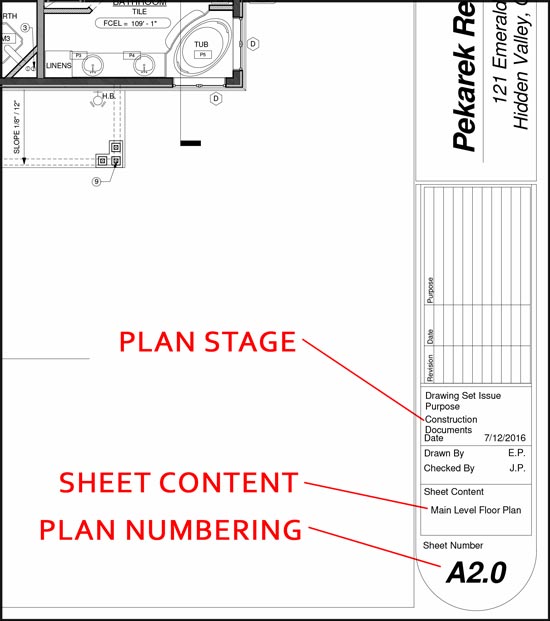
Looking at the title blocks, find the Main Level Floorplan. A floorplan is the top view of a building if it were cut 4’ above the finished floor. This plan will give you a lot of information about the project, but most importantly it will show you the layout for the building. The floorplan won’t necessarily be the first page though. For a typical set of our plans the first 2 pages would be Planning / General Notes and Specifications (page AT and AS) including the Site Plan. The floorplan would be the next sheet, which may be called A1.0. Don’t get fixated on the page numbering. You may have more or less pages in your construction document set depending on your project.
Start with the title block. Our title blocks are on the right-hand side of the page. The page numbering is on the bottom, with the Sheet content right above. Most important is the date on the title block. This will tell you if you have the most recent set of drawings.

Looking at the title blocks, find the Main Level Floorplan. A floorplan is the top view of a building if it were cut 4’ above the finished floor. This plan will give you a lot of information about the project, but most importantly it will show you the layout for the building. The floorplan won’t necessarily be the first page though. For a typical set of our plans the first 2 pages would be Planning / General Notes and Specifications (page AT and AS) including the Site Plan. The floorplan would be the next sheet, which may be called A1.0. Don’t get fixated on the page numbering. You may have more or less pages in your construction document set depending on your project.
ORIENTATION
On the Floorplan, find the north arrow. The north arrow can be found beside the title and scale at the bottom of the page. The north arrow should help orient you.
SCALE
If you have found the North arrow, then you have found the page scale (below the title). A typical Floorplan is ¼” = 1’-0”. Our clients, get an architectural ruler to help them size the parts of the plan that don’t have dimensions labeled.
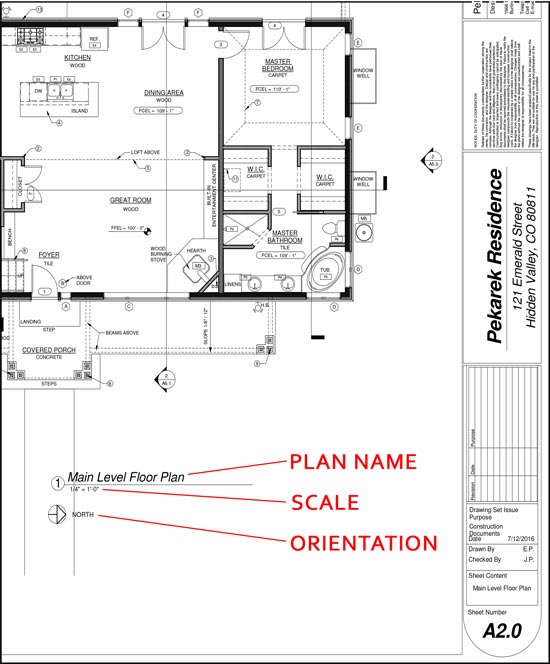

WALLS
Ok, so what am I looking at? Remember walls have thickness. A symbol’s legend, in the bottom right hand corner, will show you what different wall types look like and other useful information. Note, the wall symbols in the legend are showing symbols for full height walls. Half walls are noted with dashed outline, like the one below the counter in the floorplan below.
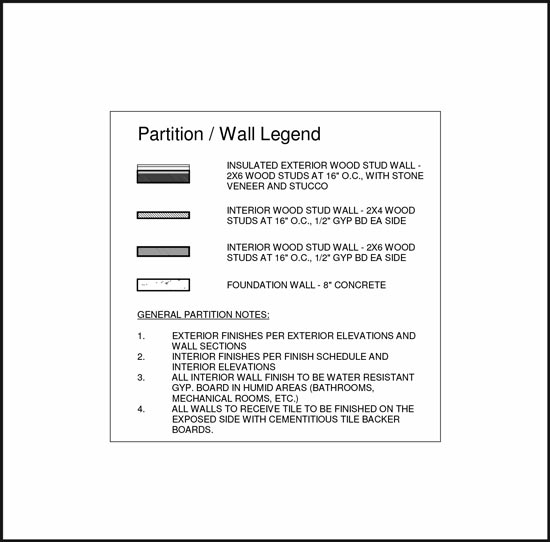
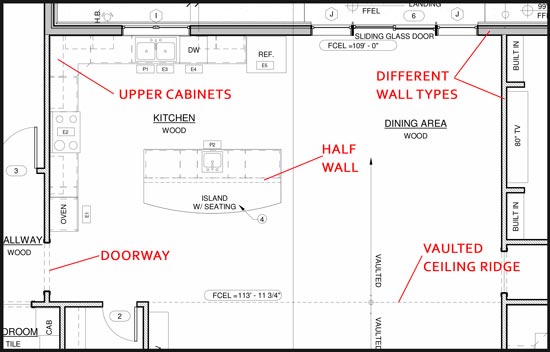


LEVEL CHANGES
Level changes in the floorplan are tricky to show, but there are a couple ways that we show level changes. First of all, we draw the staircases and label landings.
Also, we note the number of risers in a staircase run…15R. This means there is 15 risers in this staircase. The DN stands for Down. With the addition of the arrow, this tells you which direction the staircase is going…downstairs. The diagram below shows the different parts and pieces of a staircase, including risers.
Also, you may notice something that looks like this…
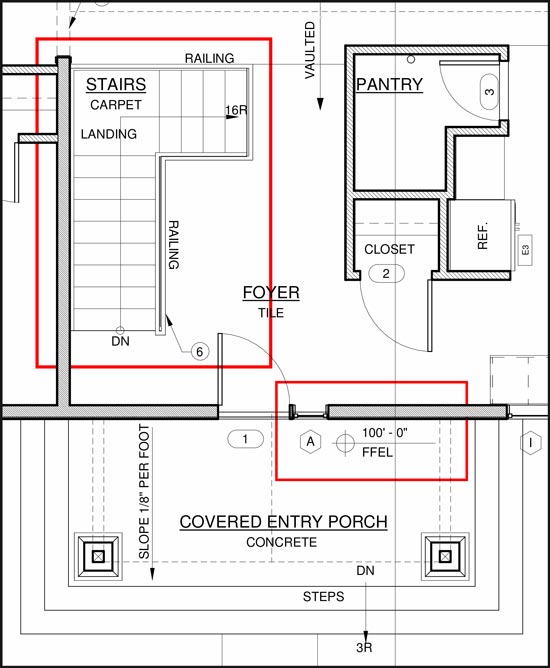
FFEL stands for Finished Floor Elevation. The Main Level is always 100’-0”. Every level change will go up or down from there. This is a relative number. Don’t confuse FFEL with the actual elevation above sea level. For the plan above, there is 16 risers, the basement has an FFEL of 90’ – 1 7/8". These same notes can be seen on the section and elevations as well.
Also, we note the number of risers in a staircase run…15R. This means there is 15 risers in this staircase. The DN stands for Down. With the addition of the arrow, this tells you which direction the staircase is going…downstairs. The diagram below shows the different parts and pieces of a staircase, including risers.
Also, you may notice something that looks like this…

FFEL stands for Finished Floor Elevation. The Main Level is always 100’-0”. Every level change will go up or down from there. This is a relative number. Don’t confuse FFEL with the actual elevation above sea level. For the plan above, there is 16 risers, the basement has an FFEL of 90’ – 1 7/8". These same notes can be seen on the section and elevations as well.
WINDOWS AND DOORS
Windows and Doors can be viewed on the floorplan. The floorplan will only tell you the width of the window and doors, not the height. Each door and window that is getting replaced or added during construction will have a label by it. Numbers for doors (usually starting with the front door) and letters for windows. You will find these same letters and numbers on the window and door schedule on page AS. On the schedule, you will find actual sizes of windows and doors, quantity of each size, type and other important information. Note: the size of the schedule is the actual size of the window or door. The R.O. size on the floorplan tells the contractor what size to frame the rough opening for that particular window or door.
ELEVATION AND SECTIONS
The last thing, what are all these arrows on my floorplan? Elevation markers tell you the elevation you will see on a certain page number. An elevation is a flat drawing (without perspective) of an area as if you were standing there looking at it. So, a North Elevation would be the north-facing wall of a building. Elevations show you and the contractor materials, roof type and pitch, exterior materials, etc. A similar arrow can be found attached to a line. This is a section symbol. A section shows what the building would look like if we could cut the building with a knife and took away part of it. Sections show many important construction details for the contractor, as well as heights of levels and ceilings.